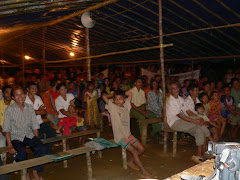Saving traditional Dayak tattoos
The
Erma Ranik, Contributor,
If you happen to visit
The salons lure would-be customers with tattoos of varying styles, crafted with more ""modern"" equipment and techniques. Few offer traditional methods and motifs.
Although tattooing is often associated with thuggery, the art remains popular even now. For the Dayak ethnic group, which consists of various minor ethnic groups, tattoos are part of their tradition, and to make it last, people innovate.
Among some minor ethnic groups, especially the Iban, tattoos used to be compulsory for both men and women, using traditional motifs and styles.
Over the course of time, however, people have increasingly come to shun the traditional styles and instead, they have ""modern"" motifs painted on their bodies. Now, only a few Iban retain the knowledge of traditional tattoo designs and techniques practiced by their ancestors.
Among the few Iban tattoo artists still loyal to traditional motifs is Patek, who lives in a longhouse in Nanga Sadap of Embaloh Hilir subdistrict.
Patek, who inherited the skill from his father, Sigi, has vowed to remain a specialist in Iban Dayak traditional tattooing.
""As a little boy, I would make tattoos on my brothers and sisters. As a novice in the art, I would do it just for fun -- piercing their skin with a needle,"" he recalled.
Patek said it took a lot of time and pain to learn the art of tattooing. Years of observing his father work was not enough to develop his own flair.
""I became skillful after I lived in
To be an Iban tattoo artist is not easy, as the local custom demands a lot of requirements, including being certified through a traditional ceremony.
In the Iban community, both men and women may equally become a tattoo artist.
""In the past, there was an elderly tattoo mistress, but none of her children inherited her talent,"" Patek said.
As an artist, Patek -- whose name means ""thunder"" in the Iban dialect -- is well-versed in the various traditional motifs and their meanings. For example, an Iban will have a certain motif tattooed on his body after he returns from living outside the Iban community.
""If an artist drew the wrong motif, it would be a humiliation for both the tattoo-owner and the artist,"" he said.
The Iban boast many tattoo motifs that are to be painted on people with specific backgrounds or professional skills. There are, for example, motifs for women who have an exceptional skill in weaving.
One of the most difficult motif to make is called Uker degok, which is drawn on the neck. In the past, this motif was awarded to someone who had successfully ngayau, or beheaded an enemy for a ritual.
However, as ngayau has been officially banned, the motif has now become a part of Dayak history. Patek recalls that the last time Uker degok was made was in 1967, when many Iban were involved in the campaign to quell a separatist uprising led by Serawak Guerrillas and the North Kalimantan People's Army.
Patek, a father of three, is also knowledgeable about the tattoo style of another Dayak minor ethnic group, the Kayaan.
""The Kayaan style is the most complicated of all traditional styles I know. There are a great many intricate details that only the seasoned artist can accomplish,"" he said.
The Iban traditional motif is drawn in a single color, black. Patek uses lampblack as the main component, and will draw the motif directly, without an initial sketch.
""Once I get an idea about the motif, I will fill the needle with the soot, and there it goes -- my hand works on its own.""
To make a simple traditional motif, Patek needs about two hours.
""If you wish to have it (a traditional motif), I can do it right now,"" said Patek eagerly.
Working as a traditional tattoo artist is not a financially rewarding profession. Patek earns Rp 50,000 (almost US$5) for each service, and orders are hard to come by. He said that he has about three customers every month.
To make the ends meet, he also runs a business as a trader with his wife. In his spare time, he makes wood carvings for sale.
""It's not bad; it's enough to survive,"" Patek said with a smile.





Tidak ada komentar:
Posting Komentar